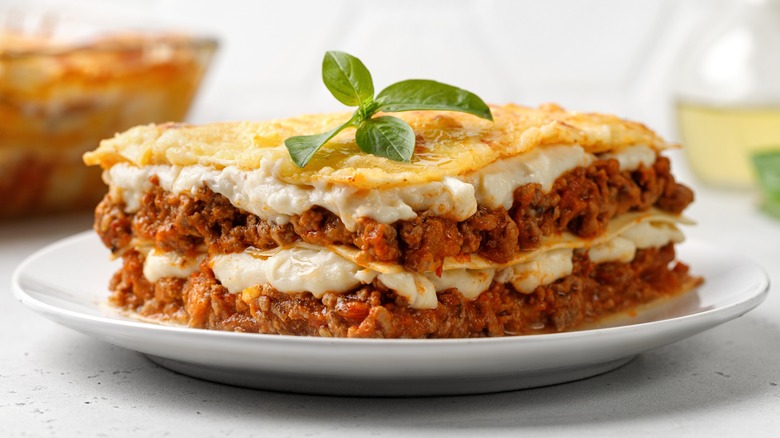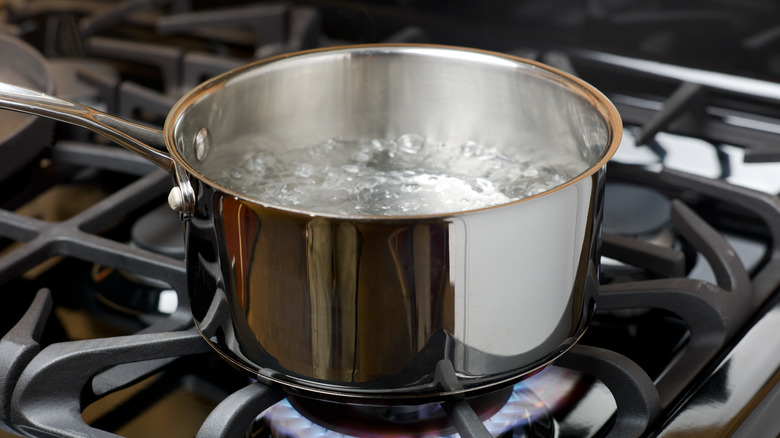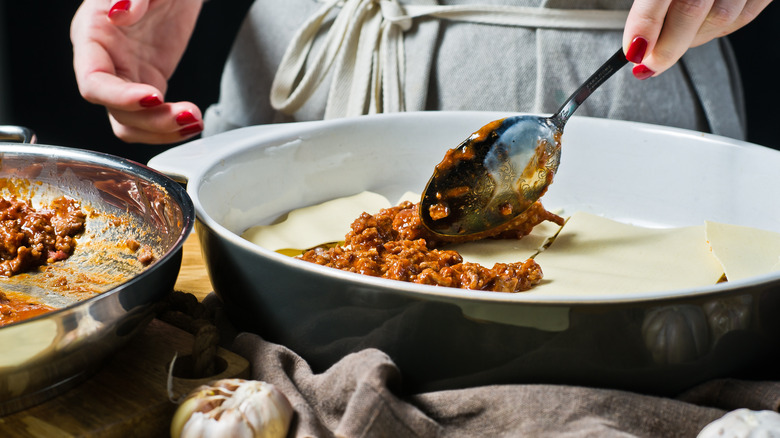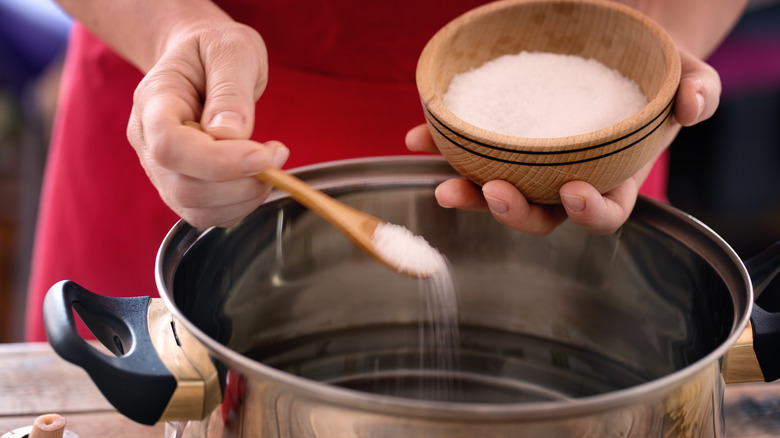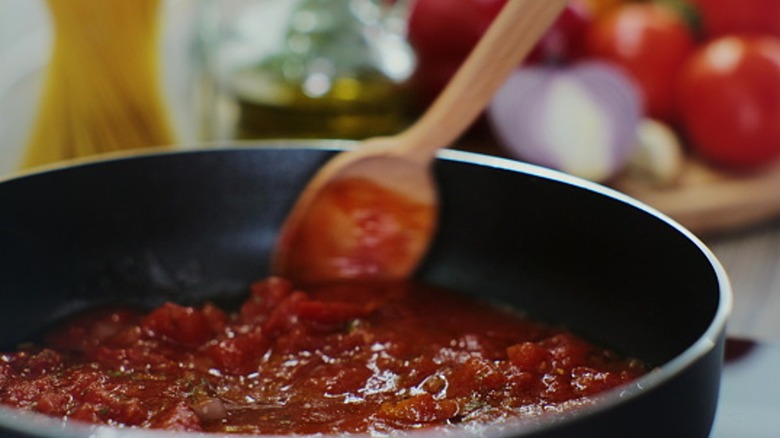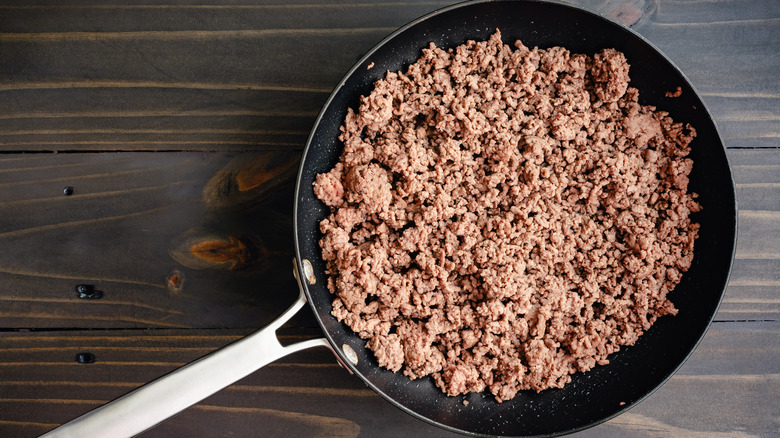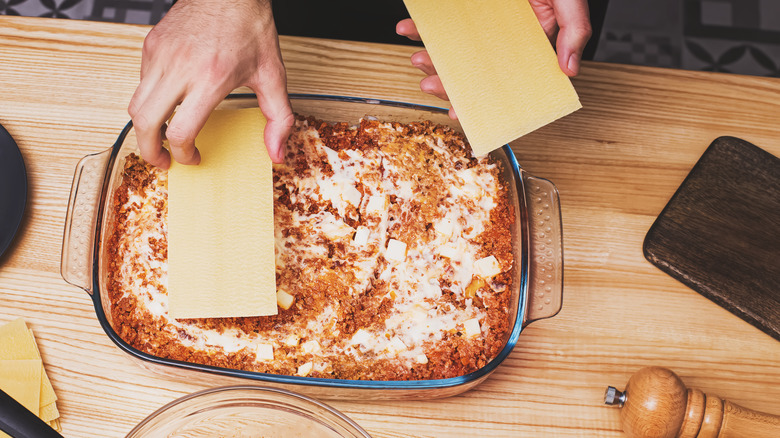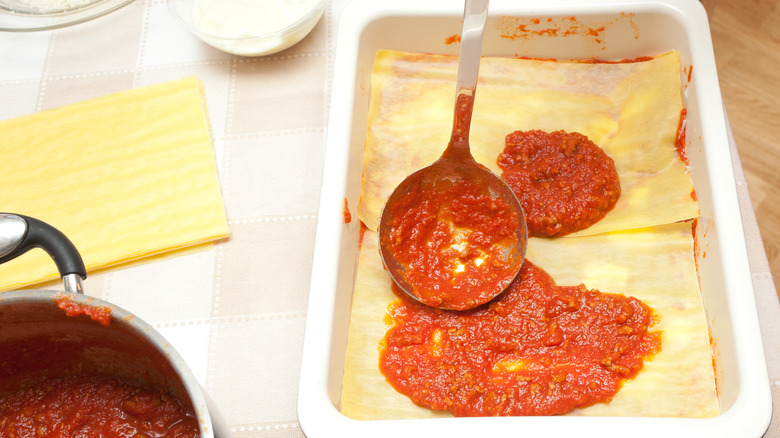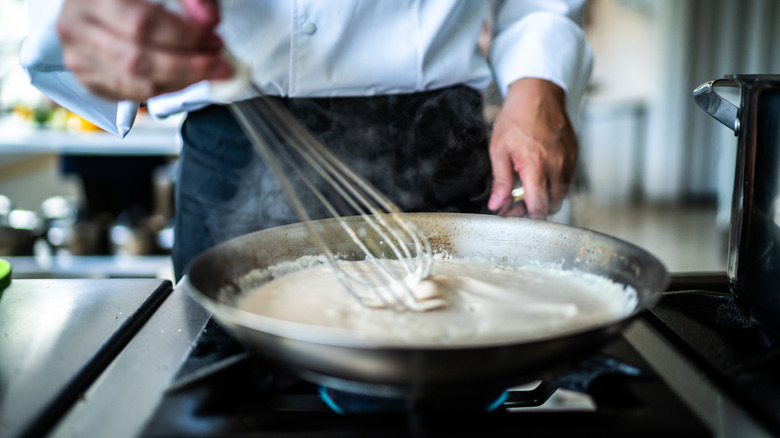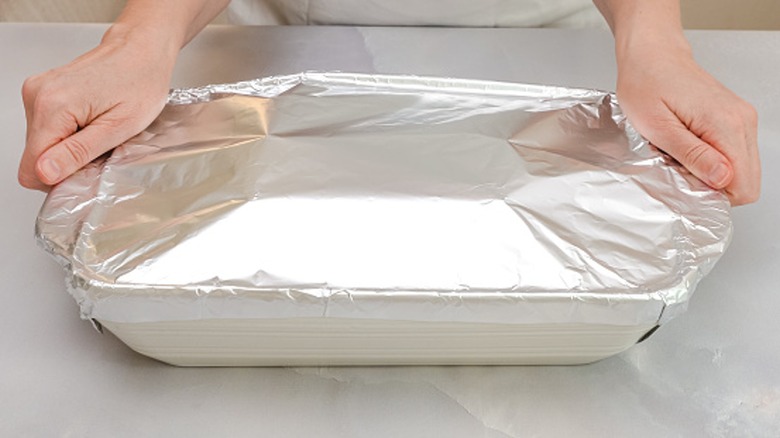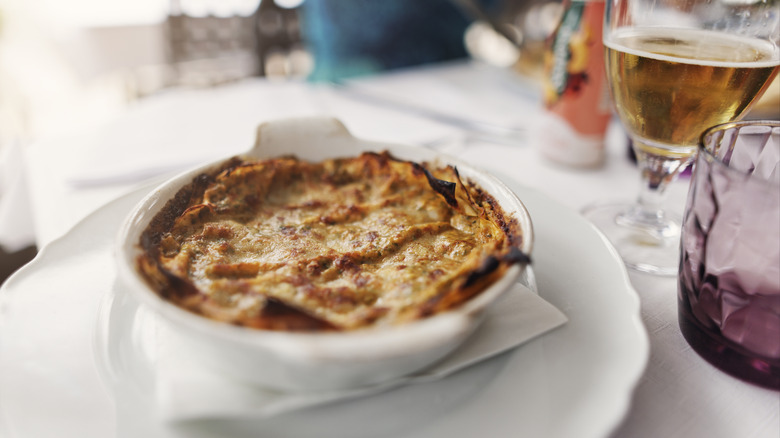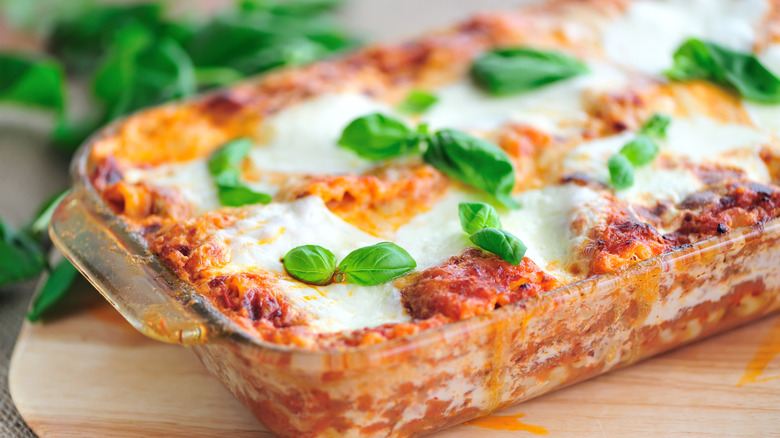12 Mistakes Everyone Makes When Cooking Lasagna, According To A Personal Chef
We may receive a commission on purchases made from links.
When you think of lasagna, do you dream of the saucy, cheesy, and utterly delicious Italian entrée? Or do you have nightmares of trying to make the layered pasta dish yourself, only to have it turn out burnt and fall apart when you try to serve it? While many people know how to order lasagna when dining in an Italian restaurant, not everyone knows how to get it to turn out right when cooking it at home.
If you're like many, you may have even given up on trying to make lasagna after some failed attempts in the past. If so, consider this a chance at a new beginning. To help us help you, we contacted Sylvia Graf Carrethers, personal chef and owner of Simply Prima, for her expert advice. She shared some common mistakes people make when preparing lasagna and what you should do instead. Read through her words of wisdom, and you'll be ready to make a perfect pan of cheesy, saucy, and downright scrumptious lasagna.
1. Over (or under) cooking the pasta
If you don't cook the lasagna noodles properly, there is little hope for the finished product. Undercooked lasagna noodles will be too firm and chewy. They will leave the lasagna tasting dry and enjoyable. On the other hand, you don't want to end up overcooking the noodles, either. Overcooked pasta becomes very soft and mushy. Not only will the finished dish fall apart when you try to serve it, but if the noodles are too soft, they may break apart when you're trying to layer the dish.
Cooking lasagna noodles is a bit different from cooking other types of pasta. This is because the noodles will continue to cook in the oven with the sauce and cheese, further softening them. Sylvia Graf Carrethers says, "cook according to package instructions," and don't forget to "set [the] timer." This will ensure your noodles don't end up too soft or firm. She recommends setting a timer to avoid getting distracted or losing track of time. Don't forget to also follow the package instructions regarding the amount of water to use to cook the pasta to ensure that the noodles have sufficient room to cook without sticking together.
2. Not draining the pasta quickly enough
After your lasagna noodles have finished cooking, Sylvia Graf Carrethers explains that it is important to "drain [the] pasta promptly in [a] colander." If you're in the middle of doing something else or aren't quite ready to assemble the lasagna, it may be tempting to remove the pan from the burner so you can drain it later, but this is a serious mistake that you'll end up regretting.
As long as the pasta is sitting in hot water, it will continue cooking, even if you have pulled it away from the burner. This will result in overcooked lasagna noodles, which, as you now know, will become mush. Even if it means pausing something else you're working on, you'll want to drain the lasagna noodles as soon as they are cooked — but make sure you do not rinse the pasta after draining it. Some good advice would be to wait to boil the noodles until you know you're almost ready to assemble the lasagna. This way, you won't need to worry about them being done too early.
3. Not seasoning the pasta water
Many people may think adding salt to pasta water is a small and insignificant step, but it's one you mustn't overlook. Without salt, you will be left with bland lasagna noodles, negatively impacting the finished meal's overall taste. Sylvia Graf Carrethers says you should "generously salt pasta water." She emphasizes that "it should taste as salty as ocean water." Aim for 1 tablespoon of salt when cooking a 1-pound package of lasagna noodles.
Adding salt to the pot at the right time is also important. Wait until the water is boiling, but add the salt before the lasagna noodles. This way, the noodles will benefit from cooking in the salted water for the duration of their cooking time. But, you also won't risk letting the salt crystal scratch the bottom of your pan or cause pitting, as they may do when added to cold water.
4. Making the meat sauce too watery
No one wants a watery meat sauce with any type of pasta dish. But with lasagna, a watery sauce can be even more disastrous than it will be with other dishes. If the sauce is too watery, it will not stay in place between the layers of meat and cheese and is going to run out into the pan when you try to cut a piece of the lasagna.
A few potential mistakes can leave you with watery meat sauce. The first is not letting it cook long enough. Sylvia Graf Carrethers recommends cooking "down [the] meat sauce to [a] very thick consistency" before layering it with the cheese and lasagna noodles. Cooking down sauce isn't complicated, but you'll want to follow the right process to ensure the sauce doesn't stick and that the liquid content is decreased. Begin by heating the pot of sauce until it boils. As soon as it starts bubbling, decrease the burner temperature to low/medium-low and let the sauce simmer. Stir it periodically to ensure it doesn't stick or burn to the bottom of the pan.
5. Not browning the meat
A good meat sauce is a crucial component of a tasty lasagna. Yet, many people don't know how to make the sauce properly. One mistake some make is adding ground beef (or ground turkey, chicken, etc.) to the tomato sauce without browning it first. Sure, the meat could technically cook in the sauce, but you would be missing out on so much flavor if you were to skip browning it first.
When you brown meat, it undergoes the Maillard reaction, which significantly impacts the taste of the finished product. When the meat is browned, the proteins and natural sugars in the meat caramelize, deepening the flavor of the sauce. Sylvia Graf Carrethers recommends "cook[ing] meat over medium-high heat." She adds, "Don't stir too much and don't overcrowd [the] pan." So, taking just a few minutes extra to layer up the flavor in your meat sauce could be the difference between a plate wiped clean or piles of sauce scooped to the side.
6. Not properly layering the noodles
If you want each piece of lasagna to look picture-perfect, then you must also know how to layer the noodles. Sylvia Graf Carrethers explains that the "noodles should lay neatly side by side to support [the[ meat layer." She advises against overlapping the noodles. They may stick together if they overlap and make the lasagna too gummy. Carrethers also explains that you should "lay all the layers of noodles in the same direction so you can slice lasagna easily."
Beyond placing all the noodles in the same direction and ensuring they do not overlap, you must also know the correct order to layer the noodles, sauce, and cheese. Always start with a little sauce on the bottom of the pan to keep the noodles from getting dried out or stuck. Then, place the lasagna noodles, followed by a layer of cheese and then a layer of meat sauce. Repeat the layers two to three times, then add a final layer of sauce and cheese to the top of the pan.
7. Choosing the wrong type cheese
Lasagna wouldn't be lasagna without the cheese. It is what pulls the dish together and makes it ooey, gooey, and utterly delicious. However, Sylvia Graf Carrethers explains that you must be careful when choosing which cheese to use when preparing the dish. She recommends choosing "cheeses that melt easily and have flavors that work well with each other." You can always purchase pre-shredded cheese at the store, but grating at home can save you money and provide a fresher alternative. If you do decide to try it at home, don't forget that cooking spray can make cheese easier to grate. Carrethers highlights "Mozzarella, parmesan, ricotta, Pecorino Romano, [and] fontina" as excellent lasagna candidates.
While many cheeses do work well for lasagna, there are some others that you should stay away from. Cheddar is one example. While it may taste good on a platter of cheese and crackers, it is a bit too tangy and sharp for lasagna, and when it melts, it produces a lot of oil unless mixed with other cheeses. Moreover, the finished dish won't be as smooth and creamy. American cheese is another type you'll want to skip when making lasagna. While this cheese type melts well, its texture and flavor aren't right for lasagna. Don't wind up disappointed.
8. Not using enough meat sauce
One of the worst things you could do when layering your lasagna is to skimp on the meat sauce. While meat sauce certainly plays an important role by contributing to the overall flavor of the pasta dish, it does so much more than that. Sylvia Graf Carrethers explains, "You don't want your noodles to dry out." To prevent this from happening, she says that you must "cover [them] with enough sauce." Aim for about 1 ½ cups of sauce on each layer to keep the noodles moist.
If you're using no-boil lasagna noodles, you'll want to be even more careful to make sure you use sufficient sauce — even a little more than the 1 ½ cups mentioned above. These noodles are designed to soften as the lasagna bakes in the oven. However, if there isn't enough moisture from the sauce, then they will turn out overly hard and chewy — something you definitely don't want.
9. Forgetting the white sauce
If you really want to level up your homemade lasagna game, then you must not forget the white sauce. "White sauce adds the creamy layer in your lasagna that keeps the noodles from drying out," explains Sylvia Graf Carrethers. The white sauce that plays this transformational role in lasagna is formally known as béchamel sauce.
Despite its fancy-sounding name, Béchamel sauce is relatively simple to make and requires just three ingredients: butter, milk, and flour. Start by making a roux with some melted butter and flour. Then, whisk in some milk until smooth and simmer until the sauce thickens. Béchamel sauce is best when used fresh, but you can store it in the fridge if necessary. Just be sure to cover the surface of the sauce — not just the container — with plastic wrap to keep a skin from forming over the sauce. When you're ready to assemble the lasagna, add a layer of Béchamel sauce over each layer of meat sauce.
10. Forgetting to cover the top before baking
After sprinkling the last layer of cheese on top of their lasagna, many people make the mistake of placing it into the oven right away. However, as Sylvia Graf Carrethers shares, you must "cover lasagna with aluminum foil for most of the time in [it is in] the oven." Covering the pan with foil serves two important purposes. First, it helps trap moisture in the baking dish. If all this moisture were to escape, you'd be left with dried-out lasagna that would not be very pleasant to eat. This is also why covering the baking dish with foil is the best way to reheat lasagna.
Covering the pan with foil also helps prevent the top cheese layer from burning. Lasagna typically takes 45 minutes to 1 hour to cook in the oven. If the top layer of cheese is exposed throughout this entire time, it will get overly crispy and detract from the finished dish. However, you want the top layer of cheese to melt and brown a little before serving. To accomplish this goal, Carrethers says, "Uncover [the lasagna for the] last 15 minutes until [the cheese is] browned."
11. Using the wrong size pan
Choosing the wrong pan size for your lasagna will surely have catastrophic consequences. First, as we mentioned earlier, you don't want the lasagna noodles to overlap as you are layering them. If the pan you choose isn't long or wide enough, then you will end up cramming the noodles in, and they will have to overlap to fit. If you plan to make a full lasagna recipe, use a 9 x 13-inch baking pan. This will provide sufficient room for the lasagna noodles to fit without overlapping.
However, the width and length of the pan are not the only things you should think about. As Sylvia Graf Carrethers explained, the "pan should be big enough to hold all your layers." So, choosing one that is deep enough is essential. If you want your lasagna piled high with lots of layers of noodles, cheese, and sauce, look for a pan deeper than the standard 2 to 3 inches.
12. Not experimenting with the recipe
Once you've mastered the techniques necessary to make a traditional lasagna recipe, Sylvia Graf Carrethers recommends experimenting and tweaking the standard dish. She says, "Explore different ingredients and spices to come up with your own version. Go for it and be creative!" Carrethers shares good advice. While a hot serving of traditional lasagna is mouth-watering and delicious, some unique takes on this classic recipe can introduce new flavors and offer some excitement of their own.
Consider modifying one or more of the key ingredients and exploring different flavor combinations. For example, replace the classic tomato meat sauce with some alfredo sauce. Or, if you like chicken alfredo, you could even try adding some chopped-up chicken to the sauce. You could also make additions to the recipe. Try adding some vegetables to the sauce or the layers. Spinach goes particularly well with lasagna, but you could also chop up some broccoli, squash, cauliflower, or peppers to add flavor and nutrients.
